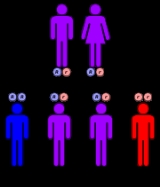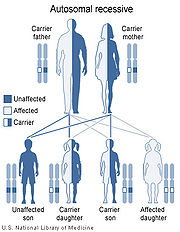
Galactokinase deficiency
Encyclopedia
Galactokinase deficiency, also known as Galactosemia type 2 or GALK deficiency, is an autosomal
recessive metabolic disorder marked by an accumulation of galactose
and galactitol secondary to the decreased conversion of galactose to galactose-1-phosphate
by galactokinase
. The disorder is caused by mutations in the GALK1 gene, located on chromosome
17q24 (McKusick, Kniffin, 2006). Galactokinase catalyzes the first step of galactose phosphorylation in the Leloir pathway of intermediate metabolism. Galactokinase deficiency is one of the three inborn errors of metabolism that lead to hypergalactosemia. The disorder is inherited as an autosomal
recessive trait. Unlike classic galactosemia, which is caused by deficiency of galactose-1-phosphate uridyltransferase, galactokinase deficiency does not present with severe manifestations in early infancy. Its major clinical symptom is the development of cataracts during the first weeks or months of life, as a result of the accumulation, in the lens, of galactitol, a product of an alternative route of galactose utilization. The development of early cataracts in homozygous affected infants is fully preventable through early diagnosis and treatment with a galactose-restricted diet. Some studies have suggested that, depending on milk consumption later in life, heterozygous carriers of galactokinase deficiency may be prone to presenile cataracts at 20–50 years of age (Kalaydjieva, et al. 1999).
 Galactokinase deficiency is an autosomal recessive disorder, which means the defective gene responsible for the disorder is located on an autosome
Galactokinase deficiency is an autosomal recessive disorder, which means the defective gene responsible for the disorder is located on an autosome
(chromosome 17 is an autosome), and two copies of the defective gene (one inherited from each parent) are required in order to be born with the disorder. The parents of an individual with an autosomal recessive disorder both carry
one copy of the defective gene, but usually do not experience any signs or symptoms of the disorder.
Unlike galactose-1-phosphate uridyltransferase deficiency, the symptoms of galactokinase deficiency are relatively mild. The only known symptom in affected children is the formation of cataracts, due to production of galactitol in the lens
of the eye. Cataracts can present as a failure to develop a social smile and failure to visually track moving objects.
Surgical Care
Consultations
Diet
Activity
(Roth MD, Karl S. 2009)
Autosome
An autosome is a chromosome that is not a sex chromosome, or allosome; that is to say, there is an equal number of copies of the chromosome in males and females. For example, in humans, there are 22 pairs of autosomes. In addition to autosomes, there are sex chromosomes, to be specific: X and Y...
recessive metabolic disorder marked by an accumulation of galactose
Galactose
Galactose , sometimes abbreviated Gal, is a type of sugar that is less sweet than glucose. It is a C-4 epimer of glucose....
and galactitol secondary to the decreased conversion of galactose to galactose-1-phosphate
Galactose-1-phosphate
Galactose-1-phosphate is an intermediate in the intraconversion of glucose and galactose.It is formed from galactose by galactokinase....
by galactokinase
Galactokinase
Galactokinase is an enzyme that facilitates the phosphorylation of α-D-galactose to galactose 1-phosphate at the expense of one molecule of ATP. Galactokinase catalyzes the second step of the Leloir pathway, a metabolic pathway found in most organisms for the catabolism of β-D-galactose to glucose...
. The disorder is caused by mutations in the GALK1 gene, located on chromosome
Chromosome
A chromosome is an organized structure of DNA and protein found in cells. It is a single piece of coiled DNA containing many genes, regulatory elements and other nucleotide sequences. Chromosomes also contain DNA-bound proteins, which serve to package the DNA and control its functions.Chromosomes...
17q24 (McKusick, Kniffin, 2006). Galactokinase catalyzes the first step of galactose phosphorylation in the Leloir pathway of intermediate metabolism. Galactokinase deficiency is one of the three inborn errors of metabolism that lead to hypergalactosemia. The disorder is inherited as an autosomal
Autosome
An autosome is a chromosome that is not a sex chromosome, or allosome; that is to say, there is an equal number of copies of the chromosome in males and females. For example, in humans, there are 22 pairs of autosomes. In addition to autosomes, there are sex chromosomes, to be specific: X and Y...
recessive trait. Unlike classic galactosemia, which is caused by deficiency of galactose-1-phosphate uridyltransferase, galactokinase deficiency does not present with severe manifestations in early infancy. Its major clinical symptom is the development of cataracts during the first weeks or months of life, as a result of the accumulation, in the lens, of galactitol, a product of an alternative route of galactose utilization. The development of early cataracts in homozygous affected infants is fully preventable through early diagnosis and treatment with a galactose-restricted diet. Some studies have suggested that, depending on milk consumption later in life, heterozygous carriers of galactokinase deficiency may be prone to presenile cataracts at 20–50 years of age (Kalaydjieva, et al. 1999).
Genetics

Autosome
An autosome is a chromosome that is not a sex chromosome, or allosome; that is to say, there is an equal number of copies of the chromosome in males and females. For example, in humans, there are 22 pairs of autosomes. In addition to autosomes, there are sex chromosomes, to be specific: X and Y...
(chromosome 17 is an autosome), and two copies of the defective gene (one inherited from each parent) are required in order to be born with the disorder. The parents of an individual with an autosomal recessive disorder both carry
Genetic carrier
A genetic carrier , is a person or other organism that has inherited a genetic trait or mutation, but who does not display that trait or show symptoms of the disease. They are, however, able to pass the gene onto their offspring, who may then express the gene...
one copy of the defective gene, but usually do not experience any signs or symptoms of the disorder.
Unlike galactose-1-phosphate uridyltransferase deficiency, the symptoms of galactokinase deficiency are relatively mild. The only known symptom in affected children is the formation of cataracts, due to production of galactitol in the lens
Lens (anatomy)
The crystalline lens is a transparent, biconvex structure in the eye that, along with the cornea, helps to refract light to be focused on the retina. The lens, by changing shape, functions to change the focal distance of the eye so that it can focus on objects at various distances, thus allowing a...
of the eye. Cataracts can present as a failure to develop a social smile and failure to visually track moving objects.
Gene Structure
The human GALK1 gene contains 8 exons and spans approximately 7.3 kb of genomic DNA. The GALK1 promoter was found to have many features in common with other housekeeping genes, including high GC content, several copies of the binding site for the Sp1 transcription factor and the absence of TATA-box and CCAAT-box motifs typically present in eukaryotic polymerase II promoters. Analysis by 5-prime-RACE PCR indicated that the GALK1 mRNA is heterogeneous at the 5-prime end, with transcription sites occurring at many locations between 21 and 61 bp upstream of the ATG start site of the coding region. In vitro translation experiments of the GALK1 cDNA indicated that the protein is cytosolic and not associated with endoplasmic reticulum membrane (Kalaydjieva, et al. 1999).Treatment
Medical Care- Treatment may be provided on an outpatient basis.
- Cataracts that do not regress or disappear with therapy may require hospitalization for surgical removal.
Surgical Care
- Cataracts may require surgical removal.
Consultations
- Biochemical geneticist
- Nutritionist
- Ophthalmologist
Diet
- Diet is the foundation of therapy. Elimination of lactose and galactose sources suffices for definitive therapy.
Activity
- No restriction is necessary.
(Roth MD, Karl S. 2009)

